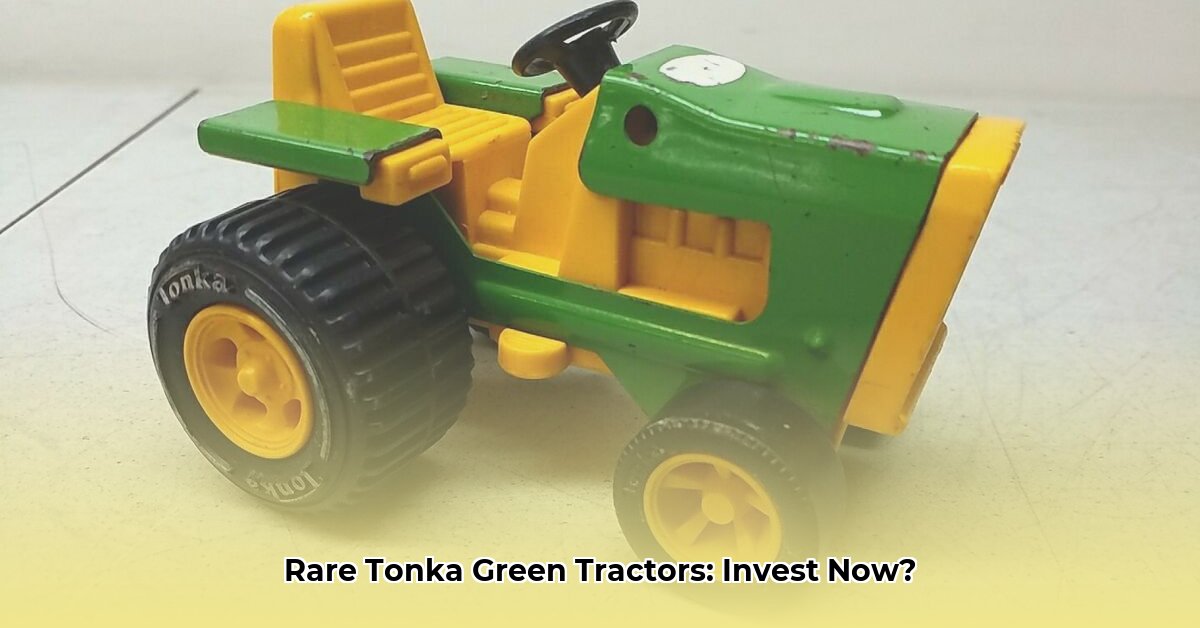
The iconic clunk of a Tonka truck—a sound that resonates with childhood memories for millions. But for a growing number of enthusiasts, that sound signifies far more than nostalgia; it's the call of a surprisingly lucrative collecting hobby. This guide delves into the world of collectible Tonka green tractors, offering insights for both seasoned collectors and curious newcomers. We'll explore what makes these tractors valuable, where to find them, and how to build a collection you'll cherish. For similar vintage tractors, check out this guide on vintage tractors.
Understanding the Value of Tonka Green Tractors
The allure of the Tonka green tractor transcends mere childhood playthings. These sturdy metal marvels represent a bygone era of simplicity and robust craftsmanship. But what exactly elevates certain Tonka tractors to coveted collector's items? The answer lies in a trifecta of factors: rarity, condition, and originality.
Rarity: The Scarcity Factor
Just like rare baseball cards or stamps, limited production runs and unique features dramatically influence a Tonka tractor's value. Certain models, produced in smaller quantities or with unique characteristics (e.g., specific paint variations, specialized accessories), are highly sought after. Online forums dedicated to vintage toys, such as the highly recommended Tiny Tonka Toys Guide (Source 1), are invaluable resources for uncovering information on production numbers, model variations, and relative rarity. Did you know that certain early 1960s models with specific casting variations can fetch thousands of dollars? That's a testament to the power of rarity in the collector's market.
Condition: A Collector's Grade
The condition of a Tonka tractor directly impacts its value. Even minor imperfections can significantly impact price. Collectors use a standard grading system, typically including categories such as:
- Mint: Perfect condition, often still in original, pristine packaging ("mint in box" commands the highest prices).
- Near Mint: Minor imperfections, but still in excellent condition, usually with the original box.
- Excellent: Shows some wear and tear but remains generally in good shape.
- Good: Noticeable wear and tear; repainting or other modifications could be present, lowering value considerably.
- Fair: Significant wear and tear, with noticeable damage.
- Poor: Heavily damaged, potentially beyond repair; may still hold sentimental value.
A "mint in box" tractor, untouched since its manufacture, is the holy grail for collectors, often commanding exponentially higher prices than even a near-mint example. This highlights the importance of careful preservation.
Originality: The Authenticity Advantage
Maintaining originality is paramount. Alterations, repainting, or the use of replacement parts dramatically diminish a Tonka tractor's value. The tractor must be as close to its original state as possible. This necessitates careful inspection of paint, castings, and markings, comparing your tractor to images of authentic models found through reputable online resources. Are there any subtle details suggesting a repainting job or non-original parts? This discerning eye for detail is crucial for determining authenticity and maximizing value.
Sourcing and Authenticating Your Tonka Treasure
The hunt for vintage Tonka tractors is a rewarding endeavor in itself. Where should you begin your search?
- Online Auction Sites: Sites like eBay are treasure troves, but buyer beware! Careful research and scrutiny are crucial.
- Antique Malls and Flea Markets: These can yield unexpected gems; patience and a sharp eye are essential.
- Online Collector Forums: These communities offer invaluable resources for authentication, pricing, and connecting with fellow enthusiasts.
Authenticating your find is critical. Careful comparison to known authentic examples, attention to details (paint, castings, markings), and seeking advice from experienced collectors are paramount. Remember, counterfeit tractors do exist, so thorough research is essential to protecting your investment.
Preservation and Storage: Protecting Your Investment
Proper storage is crucial for preserving the condition and value of your Tonka tractors. Keep them:
- Away from direct sunlight.
- In a cool, dry environment.
- Ideally, contained within protective display cases to minimize dust and potential damage.
These simple steps significantly extend the lifespan and value of your collection.
Market Trends and Future Potential
The market for vintage toys, including Tonka tractors, is dynamic. Prices fluctuate based on various factors, but the enduring appeal of these classic toys suggests continued collector interest. While predicting future prices is impossible, the historical trend towards increasing value for rare and well-preserved items suggests promising long-term potential, especially for "mint in box" examples. However, it's crucial to see this as a long-term investment; short-term fluctuations are inherent in the collectibles market.
Is Investing in Tonka Green Tractors Right For You?
Investing in collectible items always carries risk. However, the rewards – financial and emotional – can be significant for passionate collectors. The thrill of the hunt, the discovery of a rare find, and the satisfaction of owning a piece of Americana are invaluable aspects of this hobby. If you appreciate the meticulous nature of collecting and enjoy the challenge of authentication and preservation, then investing in Tonka green tractors could be a rewarding and potentially valuable pursuit. Remember thorough research and careful assessment are key to success.